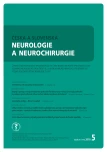Relationship between epidemiology and subjective perception of pain in patients with carpal tunnel syndome
Authors:
S. Muzikářová 1; S. Kryštofová 1; K. Ďuriš 1,2; M. Smrčka 1
Authors‘ workplace:
Neurochirurgická klinika LF MU a FN Brno
1; Ústav patologické fyziologie, LF MU, Brno
2
Published in:
Cesk Slov Neurol N 2018; 81(5): 570-575
Category:
Original Paper
doi:
https://doi.org/10.14735/amcsnn2018570
Overview
Introduction:
The aim of this research was to determine the epidemiological factors involved in carpal tunnel syndrome (CTS) development and to determine how these factors contribute to pain symptoms associated with CTS.
Patients and methods:
A questionnaire survey was conducted at the Department of Neurosurgery, University Hospital Brno. A total number of 93 patients, who underwent surgery for CTS between September 2015 and December of the same year, were included in the study. The patients responded to the questions related to CTS epidemiology and clinical problems.
Results:
CTS development was associated with age, gender, higher body weight, and thyroid gland disease. The average pain level according to the visual analog scale was 6 irrespective of the presence of epidemiological factors. The severity of pain was not dependent on any of the epidemiological factors observed in our patients except for night pain which was more frequent in women (p < 0.05). There was also a more frequent weakening of the affected hand in women compared to men (p < 0.05).
Conclusion:
CTS is related to some epidemiological factors such as age, gender, higher body weight, some associated illnesses or injuries, and manual type of occupation. However, it could not be shown that any of these factors would also mean a worse subjective perception of pain, except for night pain which was more common in women.
Key Words:
carpal tunnel syndrome – median nerve – visual analogue scale – epidemiology
The authors declare they have no potential conflicts of interest concerning drugs, products, or services used in the study.
The Editorial Board declares that the manuscript met the ICMJE “uniform requirements” for biomedical papers.
Chinese summary - 摘要
腕管综合征患者流行病学与主观痛觉的关系
介绍:
这项研究的目的是确定腕管综合征(CTS)发展中涉及的流行病学因素,并确定这些因素如何导致与CTS相关的疼痛症状。
患者和方法:
在布尔诺大学医院神经外科进行问卷调查。 本研究纳入了在2015年9月至同年12月期间接受CTS手术的93名患者。 患者回答了与CTS流行病学和临床问题相关的问题。
结果:
CTS的发展与年龄,性别,体重增加和甲状腺疾病有关。 无论是否存在流行病学因素,根据视觉模拟量表的平均疼痛水平为6。 疼痛的严重程度不依赖于我们患者中观察到的任何流行病学因素,除了夜间疼痛在女性中更常见(p <0.05)。 与男性相比,女性受影响的手更加频繁地变弱(p <0.05)。
结论:
CTS与一些流行病学因素有关,例如年龄,性别,体重增加,一些相关的疾病或伤害,以及手工类型的职业。 然而,无法证明任何这些因素也意味着对疼痛的主观感受更差,除了在女性中更常见的夜间疼痛。
关键词:
腕管综合征 - 正中神经 - 视觉模拟量表 - 流行病学
Sources
1. Kurča E. Syndróm karpálneho tunela. Cesk Slov Neurol N 2009; 72/ 105(6): 499– 510.
2. Vaverka M. Karpální tunel a neurochirurg – zkušenosti po 2 200 operacích. Cesk Slov Neurol N 2012; 75/ 108(1): 44– 50.
3. Aboonq MS. Pathophysiology of carpal tunnel syndrome. Neurosciences (Riyadh) 2015; 20(1): 4– 9.
4. Smrčka M, Vybíhal V, Němec M. Syndrom karpálního tunelu. Neurol Praxi 2007; 8(4): 234– 236.
5. Dufek J. Profesionální syndrom karpálního tunelu. Neurol Praxi 2006; 5: 254– 256.
6. Minks E, Minksová A, Brhel P et al. Profesionální syndrom karpálního tunelu. Neurol Praxi 2014; 15(5): 234– 239.
7. Sassi SA, Giddins G. Gender differences in carpal tunnel relative cross-sectional area: a possible causative factor in idiopathic carpal tunnel syndrome. J Hand Surg Eur Vol 2016; 41(6): 638– 642. doi: 10.1177/ 1753193415625404.
8. Song CH, Gong HS, Bae KJ et al. Evaluation of female hormone-related symptoms in women undergoing carpal tunnel release. J Hand Surg Eur Vol 2014; 39(2): 155– 160. doi: 10.1177/ 1753193413484873.
9. de Azevedo JW, de Oliveira AB, Nascimento V et al. Profile of patients on sick leave with carpal tunnel syndrome. Acta Ortop Bras 2015; 23(5): 244– 246. doi: 10.1590/ 1413-785220152305145784.
10. Fenclová Z, Urban P, Pelclová D et al. Neurologická profesionální onemocnění v České republice v letech 1994– 2009. Cesk Slov Neurol N 2012; 75/ 108(1): 70– 74.
11. Mediouni Z, Bodin J, Dale AM et al. Carpal tunnel syndrome and computer exposure at work in two large complementary cohorts. BMJ Open 2015; 5(9): e008156. doi: 10.1136/ bmjopen-2015-008156.
12. Výběrové šetření o zdravotním stavu české populace EHIS CR (dříve HIS CR). [online]. Praha: Ústav zdravotnických informací a statistiky ČR. Dostupné z URL: http: / / www.uzis.cz/ katalog/ mimoradne-publikace/ vyberove-setreni-zdravotnim-stavu-ceske-populace-ehis-cr-drive-his-cr.
13. Pilný J, Čižmář I, Brychta P et al. Chirurgie zápěstí. Praha: Galén 2006.
14. Ambler Z. Poruchy periferních nervů. Praha: Triton 2013.
15. Oktayoglu P, Nas K, Kilinç F et al. Assessment of the presence of carpal tunnel syndrome in patients with diabetes mellitus, hypothyroidism and acromegaly. J Clin Diagn Res 2015; 9(6): OC14– OC18. doi: 10.7860/ JCDR/ 2015/ 13149.6101.
16. Brunová J. Diagnostika a terapie poruch štítné žlázy - část I. Med pro Praxi 2008; 5(6): 254– 257.
17. Ali KM, Sathiyasekaran BW. Computer professionals and carpal tunnel syndrome (CTS). Int J Occup Saf Ergon 2006; 12(3): 319– 325. doi: 10.1080/ 10803548.2006.11076691.
18. Andersen JH, Thomsen JF, Overgaard E et al. Computer use and carpal tunnel syndrome: a 1-year follow-up study. JAMA 2003; 289(22): 2963– 2969. doi: 10.1001/ jama.289.22.2963.
19. Shiri R, Falah-Hassani K. Computer use and carpal tunnel syndrome: a meta-analysis. J Neurol Sci 2015; 349(1– 2): 15– 19. doi: 10.1016/ j.jns.2014.12.037.
Labels
Paediatric neurology Neurosurgery NeurologyArticle was published in
Czech and Slovak Neurology and Neurosurgery

2018 Issue 5
- Metamizole vs. Tramadol in Postoperative Analgesia
- Memantine in Dementia Therapy – Current Findings and Possible Future Applications
- Memantine Eases Daily Life for Patients and Caregivers
- Metamizole at a Glance and in Practice – Effective Non-Opioid Analgesic for All Ages
- Advances in the Treatment of Myasthenia Gravis on the Horizon
Most read in this issue
- New insights in the diagnosis and treatment of amyotrophic lateral sclerosis
- Review of diseases with restricted diffusion on magnetic resonance imaging of the brain
- Cervical vertigo – fiction or reality?
- Anaesthesia and neuromuscular disorders
